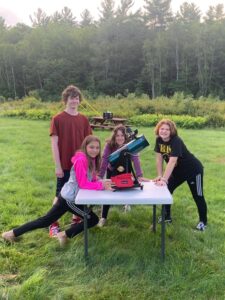COVID-19 has changed everything about the way we work and interact, but one thing is certain, public libraries have shown enormous resiliency and ability to transform themselves in the COVID era. Following is a short Q&A with Cornerstones of Science Executive Director Cynthia Randall and Program and Library Support Manager Sarah Post, which reveals some great COVID adaptations and why there’s room for optimism.
What has transformed since March?
Cindy: In the time of COVID, science kits and telescopes are all products that will mostly continue to sit on the shelves while libraries remain closed or have minimal circulation activities. We have found a way to transform these science kits and telescopes to an inventory of STEM enrichment activities, called Rev Up The Fun, that library staff and other community organizations like food distribution sites, can easily hand out to their customers. Families can explore health, energy and space themes from the safety of their homes. Check out revupthefun.org!

Campers at Camp Susan Curtis with a Cornerstones telescope
Sarah: Because of COVID-19, The NASA@ My Library Patron Interest Project (PEP) had to quickly pivot from being an in-library research project to an online format. Then, we pivoted again – with Take-and-Make bags – to align with summer reading and night sky content. We’re also working on corresponding video and journal articles based on the previous year’s data, when libraries were open, that focuses on best practices for increasing patron interest in the library setting. We also worked on a Light Pollution science kit for the National Institute of Health, with an emphasis of making it accessible for low-sited and blind individuals.
What do you feel have been the biggest COVID impacts on libraries?
Cindy: I see two big impacts: 1) library staff livelihoods and 2) lack of access to critical library services. COVID, has put an economic strain on funding jeopardizing library jobs. As the pandemic continues, these jobs continue to be threatened. Secondly, lack of public access to the library resources, computers, books and others services that certain populations depend on further isolates them from critical information, social contact and tools they need as part of their daily lives.
Sarah: Having the libraries closed to the public has impacted how libraries function in every way. Librarians have had to quickly change how they do their jobs and reach out to their communities because even though many libraries are closed or partially closed, many libraries are still working and trying to offer programming to patrons. Uncertainty has impacted libraries the most, which is both good and bad. Just like in the NASA@ My Library project, libraries are having to pivot multiple times to find what works best.
What’s an example of a great adaptation you have seen as a result of COVID?
Cindy: Public libraries are amazing in their resiliency and ability to transform to where the need is great, informing the public, and adapting services and programming to meet changing community needs such as: online story time, setting up food distribution sites, and even 3D printing tools to help the frontline health workers.
Sarah: Based on my observations, the sheer number of online librarian discussion groups have provided librarians support through peers to share ideas, frustrations, successes and challenges. I see librarians from all over the world contributing to these discussions and supporting one another. I can’t think of anything more important right now than finding ways to feel supported in these times.


